Know your yoga business plan and model

The good news about your yoga business plan is that there are multiple ways to run a successful yoga studio.
Owners get stuck when they
- Price they yoga services incorrectly for your capacity,
- Abandon an ideal audience, or
- Force clients to decide on membership too soon.
There’s another way. When you know
- Your unique business’ ideal customer roadmap,
- How to “squeeze the lemon” and maximize new student interest, and
- The right content to market for your business model,
You’ll flourish. To learn more, scroll down…
(This post is Chapter 2 of Yoga Advertising On Facebook: The Ultimate Guide. See a full table of contents here, or to grab a PDF copy click the button below.)
Wait – isn’t this a guide about advertising?
It is. But no matter what any Facebook ads person tell you, do not spend a penny on advertising until you have your goals totally dialed in.
This chapter will help you cement the strategy behind your sales machine.
Some fitness businesses are building intimate membership experiences and communities.
Others still will take on the challenging (but also lucrative) task of offering drop-in rates only and asking clients to book each class individually.
And others still will blend both approaches into what I call a “hybrid model”; they offer both memberships and drop-in packages.
Each of these models can be successful. Each also requires a slightly different brand and marketing approach.
Since most businesses leverage a hybrid model, we’ll mainly discuss that strategy here. We’ll also briefly reference the considerations you should take for all-membership or a la carte models.
THE THREE YOGA BUSINESS MODELS
Model #1: Hybrid
Some pillars of the hybrid business model are as follows:
- New students try you out for an introductory period of time (2-4 weeks is ideal) before making a commitment.
- Your marketing points toward membership and community, but you also sell blocks of drop-in classes.
- Your classrooms have a larger capacity – over 30 people can be in one class, and the focus is on being together as a group.
- You have flexibility to run promotions or sales and maximize revenue.
As the name implies, you’re offering both an a la carte option and a membership option to members, which allows you to cast your net wide.
Here is an example of package options in a hybrid model:
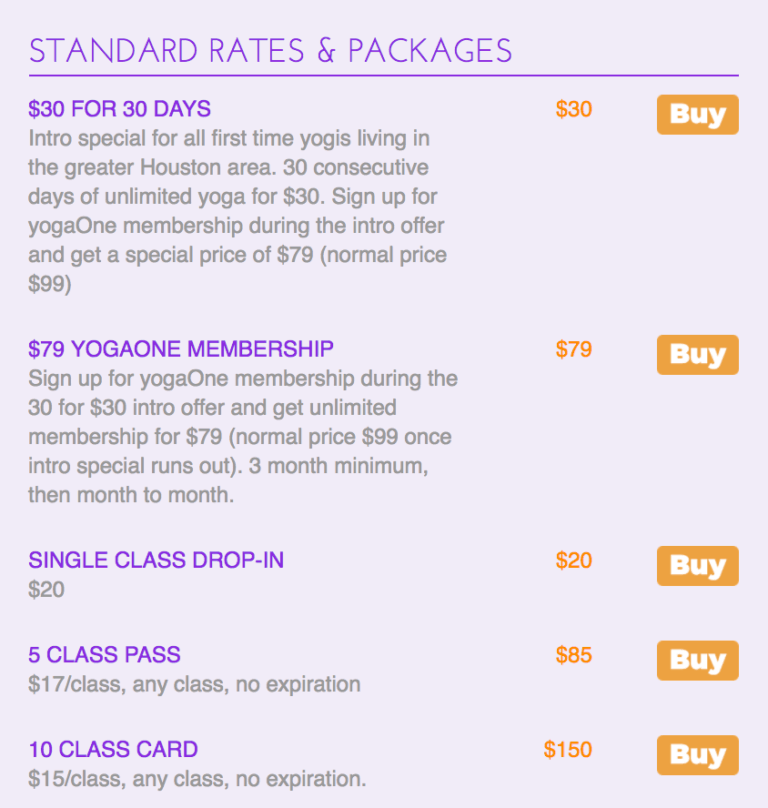
In this example, people can purchase either class passes or a monthly membership.
I LOVE this business model because you point to membership in your marketing efforts, which allows you to build monthly recurring revenue and community.
You also provide “a la carte” class passes to appeal to people with unusual schedules or who just like to bounce around.
For example, I live in Houston, Texas – a lot of young professionals here work in offshore oil and gas.
They have great salaries and relocated here for their careers, and they want community.
But their work sometimes requires them to leave town and go work on a rig for two and three-week increments.
A membership doesn’t make a lot of sense for these professionals, yet they’re able and willing to pay a premium for studio services, a change of scenery, and the feeling of connection.
Model #2: Membership Business Model
You’re familiar with the membership-only model – it’s the common model for big-box gyms like LA Fitness or Gold’s Gym.
This model is challenging for a yoga studio, but it does exist. An example is Pure Yoga in NYC; to tighten the community and reduce the droves of tourists dropping in, Pure Yoga converted to a membership-only model.

Some high-level highlights of the membership-only business model are:
- The feeling of belonging and community – everyone knows that everyone else is a member, and that makes a HUGE difference. Studios in tourist destination cities may adopt a model like this.
- You will likely lose revenue from clients that like to bounce in and out.
- Budgets and financial planning are more predictable since the vast majority of your revenue comes from membership.
Membership-only model is for you if you’re passionate about only having people who are dedicated to their practice and come on a regular basis.
Another version of membership model that you might consider is a recurring class pass. Clients pay a monthly rate to have a set number of drop-ins each month.
If they don’t use them, they lose them, and if they use ‘em up early, you can offer a solve like an a la carte drop-in rate.
Orange Theory, a boutique fitness franchise, follows this model. They offer monthly packages that give you 4 drop-ins a month, 8 drop-ins a month, or unlimited drop-ins a month.
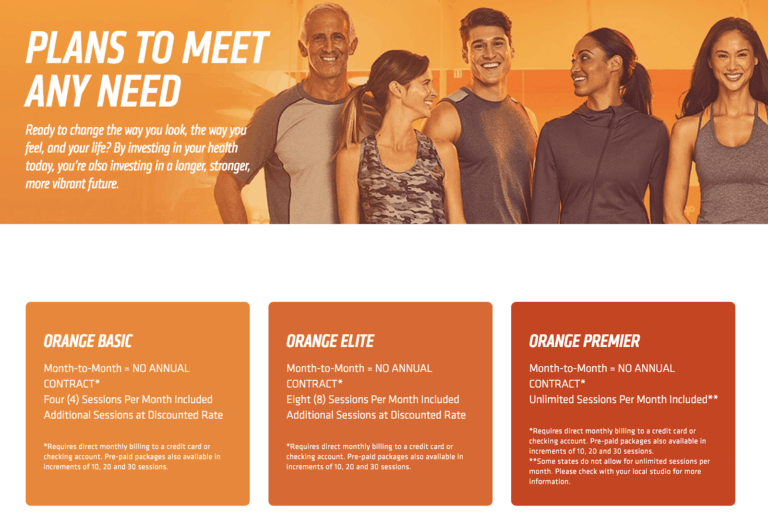
Having a “flexible membership option” like this can create more recurring revenue streams and predictability in your business.
How better member retention compounds studio revenue
Just so we’re on the same page – great member retention is what makes a big financial difference for businesses that have membership options.
Let’s hold hands and look at some numbers together.
Here’s a hypothetical situation: You’re an established studio that has about 80 new people try you out each month. About 15% of those newbies become members, and you see 2 or 3 member cancellations a week (10 per month). You’re a more upscale yoga studio with nice bathrooms and amenities, so your membership price is $150/month.
Your monthly revenue build looks like this:
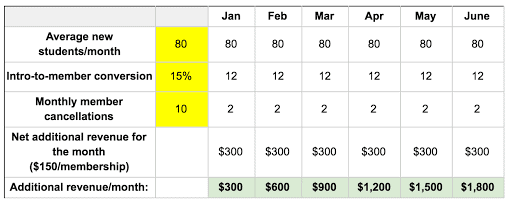
You’re getting 12 new members each month, but since ten have cancelled in the same timeframe, you have a net of two new members/month.
I mean, it’s ok. Your revenue build is slow. (Hopefully the toilet doesn’t break.)
Now let’s take the EXACT same chart – but say you host more fun challenges, promote more strategically on social media, and keep your members engaged.
Your cancellations drop to 1 or 2 a week (six per month), and you attract just a few more new clients (Let’s say 20 additional newbies a month – that’s less than one per day.)
Since more new people we’re in the picture, you have more new members – let’s say just two more per month.
Buckle up – your additional revenue per month now looks like this:

Here’s what this looks like over an additional six months:

Just so we’re clear – by December, with the same operation and classes, your business’ monthly membership revenue would be $19,800 higher than it was at the start of January.
An extra $19,800 per month? I’ll take it.
(Oh, do you want a copy of this calculator for yourself to crunch your own numbers? Get access here.)
Why use ads to reach members when I could just use email instead?
Use both.
Email is obviously valuable because it’s free.
With email though, it’s challenging to get your open rates (the people that actually open your email) up.
Even the most tantalizing email subject line might only command a 20-30% open rate – meaning that your retention efforts are only getting in front of a fraction of your audience.
Supplement your email efforts with a Facebook ad pointed directly to your customer list, and a much larger percentage of them will be aware of upcoming events.
(Again, it’s possible to upload your business’ email list into Facebook and target only those people.)
You can even call out your members or regulars at the top of your ad with brackets so people know that this sponsored post is special to them and not just a blanket advertisement from your studio.
Model #3: “A La Carte” Classes
Now, at the other end of the spectrum is a business model that offers drop-in classes only.
A drop-in only model is challenging, exciting, and helps manage profit in a low-capacity room that can’t fit as many students. It works best in studios that have a limited number of spots per class.
This model works better with fitness studios that use machines or feel more like group personal training, like a Pilates studio. You can use this approach though for workshops and specialty classes that you host at the yoga studio – similar tactics apply.
Highlights of the “A La Carte” Strategy:
- Limited capacity in classes because of room size or machines – this business model works best for class sizes under 20 or classes with specialty equipment (aerial yoga, acro yoga, or spin classes are good examples)
- Opportunity to charge higher prices because of the limited availability. Boutique studios with equipment can often command $25+ per class and offer a personalized experience.
- You’ve gotta be damn good – people only pay when they actually workout.
- Instructor personality is a huge factor, because a bigger audience and following means more revenue with this model.
- If it’s a holiday, or there’s a natural disaster, and you cancel classes, you make no money that day.
If you have limited space, this should be your preferred model. Too often I hear about reformer pilates studios with a class capacity of 10 students that are in a huge supply glut.
They sell memberships, and their members all want to hit the 5:30pm class 5 days a week.
Drop-In structure has become more popular in boutique fitness. It leverages social media heavily, as you depend on the instructor’s skill and personality to fill classes.
Create a habit-building new client special
If you’re a membership-only or hybrid business, you want people to eventually become a member. You need them to get accustomed to the feeling of being a member.
I recommend you create an intro offer that is two to four weeks in length. If your capacity can handle it, do four weeks.
The intro special should also be a steal of a deal. I recommend you make your intro offer 30%-50% of the price of your monthly membership.
In this example which we saw earlier, the intro special is one month for $30, which funnels into a membership price of $79/month. The phantom price (not shown) is $99/month.
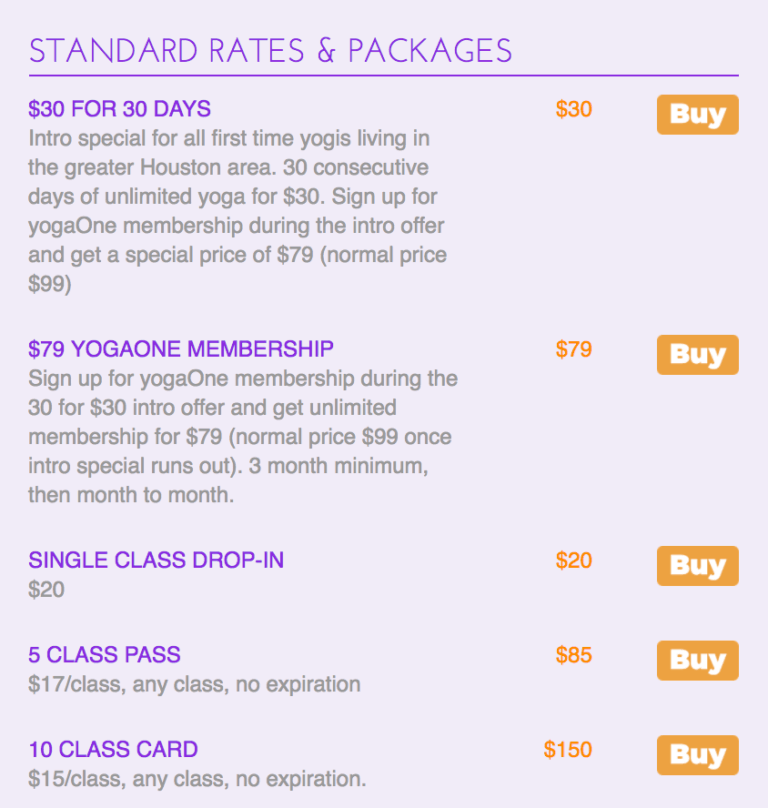
You want to be selective with discounts so you don’t cheapen your brand or train your students to wait for the next sale.
For newer students though, give them an opportunity to come check you out multiple times. This will help them get hooked on how great your classes are!
It usually takes more than one class for a student to really feel hooked and see themselves incorporating the studio into their routine on a regular basis.
Free intro offer versus paid intro offer
If you’re a membership-only or hybrid business, ALWAYS do a paid intro offer – even if you’re newer and want lots of people in the door. This builds your membership funnel and keeps class quality up.
For a drop-in model, you have a choice.
If you do a free intro offer, you’ll get a lot more people coming in. It’s also very easy for your regulars to bring a friend.
The catch is that the quality of people coming in can be all over the place. It’s also likely that you’ll have people no-show, try to cheat you, or disrespect the rules of the class.
No-shows happen a LOT, since there wasn’t any buy-in to begin with. If your class size is especially small (think reformer Pilates, for example), I wouldn’t do free – you don’t want half a class to be taken up by first-timers who paid nothing to be there and may not show, while your willing-to-pay people are left wishing they could get into class.
A paid first class at a lower rate will create lower total traffic, but those people are more likely to be committed to the class to begin with.
My personal vote is that your new student offer is always a paid offer.
How to position your membership or hybrid business model up for more sales
In a hybrid or membership model, membership is king. Here are two steps to take to perfect a business’ membership pricing model.
First, find out how often people visit your business per month, on average. Go by data if you have it. Is it three times a month? Six? Eight?
(Believe it or not, the average visits/month for yoga studios is 3.9 and the average for big-box gyms is 2.9. Don’t get too optimistic here.)
For a hybrid model, you need to position your pricing such that a membership is less expensive than purchasing that number of drop-ins each month.
Let’s say a barre studio is seeing people seven times a month on average. You should position your membership such that being a member would be less expensive than buying seven drop-ins – even at the lowest per-drop-in price.
If a drop-in is $20/class, you want you membership to be UNDER $140 ($20 x 7) per month.
That’s step one.
Now for step two, you need to make this choice a no-brainer. So we’ll use a concept called Price Juxtaposition to help prospective clients make their choice.
This goes back to pricing psychology, which Dan Ariely hilariously and beautifully demonstrates in this video.

Your target membership price should be framed as a deal. Introduce a phantom membership price that is at least 30% higher. For our barre studio, that would then be $185 a month.
(You could also do more – $199 month, et cetera. But you need to do at least 30% to create some impact.)
Now promote that clients are eligible for the lower membership rate during their introductory offer.
*
This studio now has a clear customer journey. They can promote to all new students that
- You can try them out for an intro offer of ______
- During your intro offer, if you decide to become a member, you’ll lock in a membership rate of $140/month (normally $185/month).
As a diagram, that looks like this:
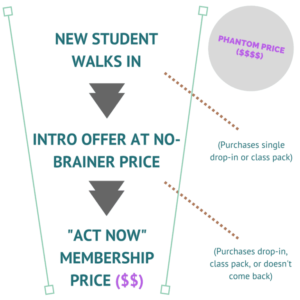
And there you go! When you frame membership as the best deal financially for people, you’ll retain more new students into members.
*
Nowwwwwww we’re ready to advertise. Direct new students to your intro offer, and measure how well you inspire introductory clients to become regular members.
When should you advertise though?
Next, we’ll tackle the best times of year to market big promotions or initiatives that build your studio attendance. Click here to dig in to Chapter 3.
And if this chapter gave you any lightbulb moments or ideas, I would love to hear about it in the comments below. 🙂

